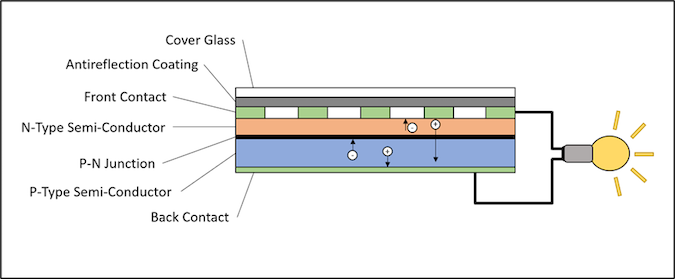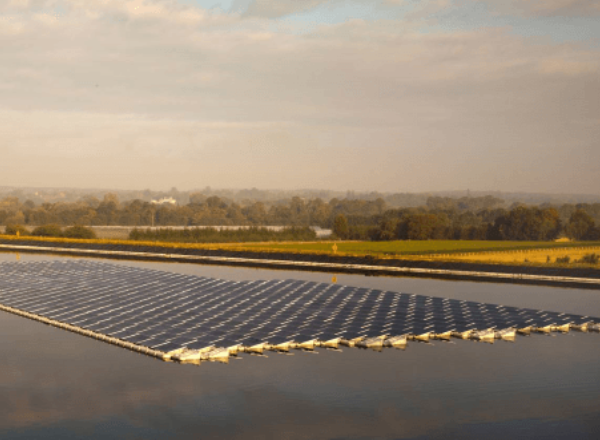Introduction
Although it may be obvious that solar panels absorb sunlight to generate electricity, you may not be aware of exactly how this sunlight is taken and converted into energy that can be used to power the lightbulbs in your home.
In this article, we provide a simple explanation of how solar panels generate electricity as well as looking at a key feature that simultaneously increases their efficiency and decreases their safety hazard.
Photovoltaic Cells
Solar panels are made up of many smaller photovoltaic cells that are joined together, with each cell comprising several layers. These are:
- Cover glass;
- Antireflection coating;
- Front contact;
- N-Type semi-conductor;
- P-N junction
- P-Type semi-conductor;
- Back contact.
A diagram of a photovoltaic cell is shown in Figure 1 below.
Figure 1 Photovoltaic cell diagram
The main component of a photovoltaic cell is a sandwich of two layers of a semi-conducting material – usually silicon. However, as silicon is not particularly good at conducting electricity on its own, it must be enhanced through a process called ‘doping’. Phosphorus is therefore added to the silicon in the N-Type layer in order to provide additional electrons and create a negative charge, whilst Boron is added to the silicon in the P-Type layer to reduce the number of electrons and create a positive charge.
This imbalance creates an electric field in the junction between the two layers and allows an electron knocked loose by a photon to flow towards the N-Type layer. The positively charged area left behind by the electron is called a ‘hole’ and flows towards the P-Type layer. Finally, creating a circuit by connecting wires to the front and back contacts will force the electrons and holes together, resulting in an electric current[1,2].
Antireflection Coating
You may have noticed that the antireflection coating was not mentioned in the previous explanation. Although the antireflection coating does not directly contribute to the generation of power, it has its own own key features that are may be just as important for solar panel to function.
When sunlight hits a solar panel, approximately 5% of the light is reflected off the cover glass[3]. The remaining light passes through the antireflection layer that has a specially chosen thickness so that interference effects in the coating cause the wave reflected from the anti-reflection coating top surface to be out of phase with the wave reflected from the semiconductor surfaces. These out-of-phase reflected waves destructively interfere with one another, resulting in zero net reflected energy[4].
This is an important feature as more of the light is kept in the solar panel and converted into energy whilst also reducing the intensity of reflected light. Therefore, without this coating, solar panels would lose too much energy to be an economically viable option and would likely represent a much greater safety hazard for an observer looking at the solar panel.
About Pager Power
Pager Power has undertaken over 550 glint and glare assessments to determine the impact of reflected light from solar panels upon aviation activity, railway operations, road users, and residential amenity. For more information about what we do, please get in touch.
References
[1]Desjardins, J., 2020. Animation: How Solar Panels Work. [online] Visual Capitalist. Available at: <https://www.visualcapitalist.com/animation-how-solar-panels-work/> [Accessed 15 December 2020].
[2]Komp, R., 2016. How Do Solar Panels Work?. [online] TED-Ed. Available at: https://ed.ted.com/lessons/how-do-solar-panels-work-richard-komp<[Accessed 15 December 2020].
[3]Federal Aviation Administration (FAA), 2020. Technical Guidance For Evaluating Selected Solar Technologies On Airports. [online] Available at: <https://www.faa.gov/airports/environmental/policy_guidance/media/FAA-Airport-Solar-Guide-2018.pdf> [Accessed 15 December 2020].
[4]PVEducation, 2013. Anti-Reflection Coatings. [online] Pveducation.org. Available at: <https://www.pveducation.org/pvcdrom/design-of-silicon-cells/anti-reflection-coatings> [Accessed 15 December 2020].




